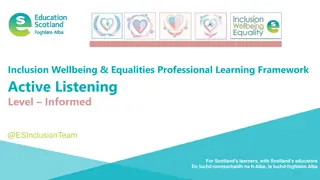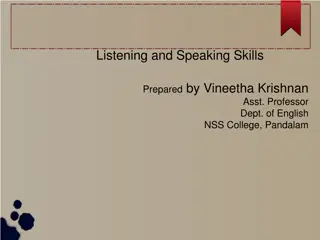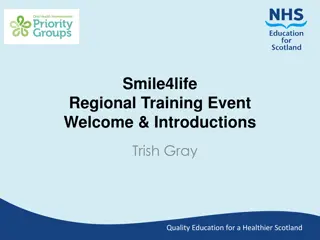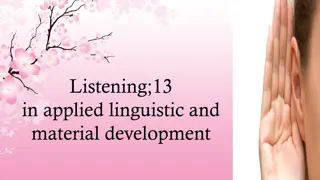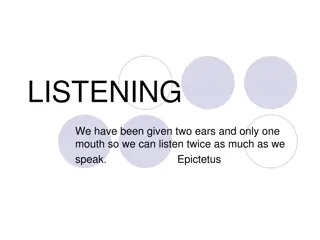Importance of Listening in Oral English Classes
Listening plays a crucial role in academic success and oral communication, requiring active engagement and interpretation of sounds. Teaching listening involves hearing word boundaries and making predictions based on various clues. Challenges in listening in a foreign language include the preparation of utterances and the importance of context.
Download Presentation

Please find below an Image/Link to download the presentation.
The content on the website is provided AS IS for your information and personal use only. It may not be sold, licensed, or shared on other websites without obtaining consent from the author.If you encounter any issues during the download, it is possible that the publisher has removed the file from their server.
You are allowed to download the files provided on this website for personal or commercial use, subject to the condition that they are used lawfully. All files are the property of their respective owners.
The content on the website is provided AS IS for your information and personal use only. It may not be sold, licensed, or shared on other websites without obtaining consent from the author.
E N D
Presentation Transcript
Listening An Important Part of your Oral English (and other) Classes in China
The importance of listening Fundamental conversational skill. Otherwise, one-sided conversations Listening is crucial to success in academic situations. What college students do most (in classes) A crucial yet invisible skill in oral communication. Something ALL of you will teach (even if listening is not part of your class title). Something most of us have never studied explicitly
What is listening? How do you teach it? Not the same as hearing Difficulties are language-related, not volume- related Not perception, but interpretation of sounds. Not passive (not just a sponge) The brain is very active while listening. Two important aspects of this process: Hearing word boundaries Making and confirming predictions
Hearing word boundaries in the stream of speech Actually, inserting/creating them (There s really nothing there to hear) Japanese: Zannennakotodesune! (how many words?) X: Zannen nakoto desu ne! A: Zannenna (regrettable) koto (matter) desu ne! Samoan: Samoamuamualeatua. (how many words?) A: Samoa muamua (first) le atua (god) Hawaiian: Uamaukeeaokaainaikapono. A: Ua mau ke ea o ka aina i ka pono. (ten words) Humuhumunukunukuapuaa A: Humuhumunukunukuapuaa (one word) Bus in Latin America: Lamolinatodojavierpradosubesube. A: La Molina todo Javier Prado sube sube.
Hearing word boundaries in the stream of speech Actually, inserting/creating them (There s really nothing there to hear) English: Mares eat oats and does eat oats and little lambs eat ivy. A kid ll eat ivy too, wouldn t you? Ray s dad s Cadillac vs. Raise dad s Cadillac Glad Lee, the cross-eyed bear vs. Gladly the cross I d bear Mother: Your brother is going to the MTC. Little child Mother, the sea s not empty; there are lots of fish in it.
Making predictions based on grammar, content, culture, etc. Psycholinguistic guessing game in oral mode I m thinking of a word. What is it? The ship came into the harbor and dropped its Note grammatical, contextual, experiential clues that allowed you to come up with the right word in a fraction of a second. Contrast with Following the doctor s orders, the man turned around and dropped his
The difficulty/challenge of listening in a foreign language Speech: utterances can be prepared in advance, restricted to known vocabulary and structures Listening: Speed, complexity controlled by speaker, not the listener. May be too fast, too difficult, etc. to understand. Triangular conversations in Japan with Teri and Japanese people on the street. Kinkakuji wa doko desyoo ka? On bullet train: Kono shinkansen wa Hiroshima ni ikimasu ka?
Potential difficulties That ESL/EFL learners will experience when listening. Packet pages 5.A.1-2 Distinguishing individual sounds Understanding intonation and stress Understanding reduced speech and juncture. Also hesitation words Recognizing redundancy Coping with noise Deducing the meaning of unfamiliar words/phrase from context Making predictions about what is going to be said next
Real-life listening Characteristics Purpose and expectations Short chunks with immediate response Visual contact between speaker and listener (except telephone) Visual/environmental clues to help with meaning Informal discourse more common than formal. To learn to listen successfully in real life, students need listening practice that has these features!
Possible Approaches Comprehension approach Avoidance of speaking (teacher does all the talking; students only listen) Total Physical Response (later today) More natural, conversational approach What you will probably do most of the time Focused listening Video demonstration (now)
Focused Listening ESL class in Chinatown district in San Francisco, California
Focused Listening video Things to note: Students speaking skills Task orientation and natural task Special difficulties in phone conversations Benefits of using audio recordings Natural English, frequent interruptions/pauses Difficulty of listening to directions; small things make a big difference! Connection and transition to speaking How writing disambiguates many of the difficult listening points
Ideas for your classes in China PHLT chapt. 19 (pp. 244-ff) has many ideas, guidelines, and activities for teaching/practicing listening Games Simon Says Telephone numbers Clock faces Bingo and prices Passage length and listening activities (p. 247) External aids (p. 250) (e.g., visitors (guest speakers), VOA tapes) MTNS, ch. 7 (pp. 104-122) p.107 Listening tasks in class p. 108-9 TPR, Dictation, Dictocomp, stories, p. 110 Focused listening (video in just a minute) p. 111 Lectures and note taking, reduced forms, tapes. PELT chapter (book) on listening
Demonstrations I m thinking of a card (Lucille Hansen, USTC) Thought or quote for the day (Brecken Schwartz, CFAU) Total Physical Response
TPR Total Physical Response Demonstration in Spanish Phase One (listening to a lecture)
Completo Envolvimiento Fsico Tres puntos importantes 1. La habilidad de entender se desarrolla m s r pidamente que la habilidad de hablar. Deducci n: La comprensi n aural del idioma debe de desarrollarse antes del habla.
Completo Envolvimiento Fsico Tres puntos importantes 2. Las personas mayores, al ense ar el idioma nativo controlan las acciones f sicas de los ni os por media de mandatos. El ni o empieza a hablar despu s de muchos meses de envolvimiento f sico siguiendo las direcciones de los adultos que lo rodean. Deducci n: La comprensi n se desarrolla por medio de las acciones f sicas.
Completo Envolvimiento Fsico Tres puntos importantes 3. El habla surge de una manera natural en el primer idioma. Nunca se le obliga al ni o a hablar. Deducci n: No trate de obligar a los estudiantes que hablen. Cuando ellos est n listos, el habla surgir de una manera natural.
Conditions for Second Language Acquisition Asher s Total Physical Response and Krashen s Natural Approach Comprehensible Input. People acquire language when it is understandable. They need to understand the intent of the message, but not every word.. Low Affective Filter. People acquire language when their anxiety level is low and they are engaged in activities in a safe, comfortable, supportive environment where they feel free to take risks in using the language. Meaningful Communication. People acquire language when they use it for real purposes. Language use must be relevant, meaningful, and authentic. Function (getting things done) takes precedence over form (grammatical correctness)
Speech Emerges in Natural Stages 1. Preproduction. Learners can comprehend second language commands but cannot speak the language yet. (use TPR here) 2. Early production. Learners comprehend more complicated language and can make simple (one or two word) responses like yes/no or names. 3. Speech emergence. Comprehension has increased to a higher level and learners can speak in phrases and sentences. 4. Intermediate fluency. Learners combine phrases and sentences and express themselves both orally and in writing.
TPR: Basic Principles Language acquisition can be accelerated through the use of kinesthetic behavior. Comprehension precedes production. Listening skill is far in advance of speaking skill. (Video example: Easter eggs) Body movements and other actions provide evidence of comprehension. Adults manipulate children s physical behavior by a massive number of commands. (Video example: Easter eggs) Speech emerges naturally; it should not be forced. Delaying speech production facilitates learning by reducing anxiety. (Video example: Table game) When speech emerges it will be imperfect, with many distortions and errors. The teacher must be patient, tolerate these errors, and focus on communication without raising the anxiety level.
TPR: Basic Procedure 1. Teacher says words/phrases and models the meaning. Students respond by doing the same action. 2. Teacher commands and models with a. A large group (the whole class) b. A small group c. An individual volunteer 3. Teacher commands without modeling. Students respond by performing the action as a. A large group (the whole class) b. A small group c. An individual volunteer 4. Teacher recombines old and new commands, in random order, with and without modeling. Students respond by performing the action as (see a., b., c. above)
TPR Examples in China Warm up (Schwartz in Beijing high school) Wake up (Beers at Jinan Communications) Listen and Draw (McEntires, page 5.C.1)
TPR Examples in China Chinese numbers and exercises Chinese taxi directions
Listening and English tests in China Importance of College English Test (and Test for English Majors) Both have listening sections Experience recent CET-4 listening activities Short passage Long passage Cloze listening Listening test preparation and practice in class Terakawa in Hefei video. Simple but successful!
Summary Listening is an important language skill Listening is a complex language skill Learning to listen in a foreign language is not easy Teaching listening involves various types of practice Teaching listening can be fun and rewarding


